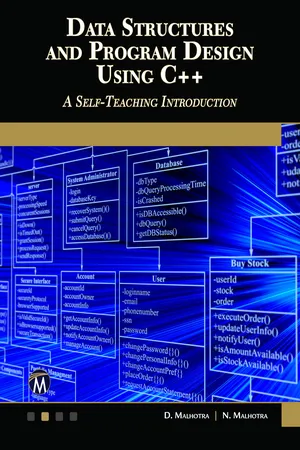Computer Science
Java Single Dimensional Arrays
Java Single Dimensional Arrays are a collection of variables of the same data type that are accessed by a common name. They are used to store a fixed number of elements of the same data type. The elements in an array are accessed using an index number.
Written by Perlego with AI-assistance
Related key terms
12 Key excerpts on "Java Single Dimensional Arrays"
- eBook - ePub
- Xingni Zhou, Zhiyuan Ren, Yanzhuo Ma, Kai Fan, Xiang Ji(Authors)
- 2020(Publication Date)
- De Gruyter(Publisher)
Array is one of our most familiar organizational forms of data. Since all the elements in an array have a unified type, and the subscript of an element in an array normally has a fixed lower and upper bound, the operations on array are normally simpler than those on other more complex structures. Almost all high-level programming languages offer array. The sequential storage distribution of various data structures also makes use of one-dimensional arrays to describe their storage structures. Multidimensional array is an extension of one-dimensional array.This section will discuss the logical structure and storage method of arrays from the perspective of data structure.4.1.1 The concept of arrays
In program design, for the convenience of processing, we organize several variables with the same type in an orderly way. This collection of data elements of the same type listed in order is called array.From the perspective of data structure, array is a finite sequence constituted of n (n ≥ 0) data elements of the same data type. Array can be viewed as a type of special linear list; it is an extension of linear list.One-dimensional array is a linear list with fixed length. Two-dimensional array is also a linear list with fixed length, with each element being a one-dimensional array.Definition of ArrayArray is a collection constituted of data elements with the same type. Each data element is called an array element (simplified as element).An n-dimensional array is a linear list, whose each element is an n − 1 – dimensional array.For example, a two-dimensional array of size m × n A[m, n] can be viewed as m rows of one-dimensional arrays, or n columns of one-dimensional arrays, as shown in Fig. 4.1 .Fig. 4.1: The relation between arrays and linear lists.A can be viewed as a linear list in the form of row-vectorsor a linear list in the form of column-vectors=A m× n,a 11a 12…a1 na 21a 22…a2 n, … ,a m1…a m2a] ]m n=A m× n,a 11a 21…a m1a 12a 22…a m2, … ,a1 na…2 na] ]m nThe appearance of the computer was initially aimed at solving problems of mathematical computations. Therefore, many concepts come from mathematics, for example, function and vector. One might say that one-dimensional arrays correspond to “vector” and that two-dimensional arrays correspond to “matrix.” - eBook - ePub
C Programming
A Self-Teaching Introduction
- Rajiv Chopra(Author)
- 2017(Publication Date)
- Mercury Learning and Information(Publisher)
CHAPTER 3ARRAYS AND POINTERS
3.0 INTRODUCTION
S ay we wish to store the marks of 3000 students at our college; if I use variables, more than 3000 variables are required. This is very tedious and cumbersome. So to solve this type of problem, we use an array that has a common name with a subscript representing the index of each element. Thus, an array is an ordered sequence of finite data items of the same data type that share a common name. The common name is the array name and each individual data item is known as an element of the array.An array is defined as a set of a similar type of elements that are stored contiguously in memory. This means that the elements of an array are stored in the subsequent memory locations starting from the first memory location of the block of memory created for the array.Each element of an array can be referred to by an array name and a subscript or an index. Please note that all elements of an array should be of similar type. Arrays can have one of more dimensions—one-dimensional (1D), two-dimensional (2D), or multidimensional. A one-dimensional array uses a single index and atwo-dimensional array uses two indexes, and so on. A 1D array can be used to represent a list of data items and is also known as a vector or a list. Similarly, a 2D array can be used to represent a table of data items consisting of rows and columns. It is also known as a matrix. A 3D array can be used to represent a collection of tables. The concept can go beyond three dimensions also.The dimension of the array is known as its rank. For instance, a 1D array has rank 1, a 2D array has a rank of 2, and so on. The number of subscripts is determined by the rank of an array. Thesize or length of each dimension is represented by an integral value greater than or equal to 0. The total number of elements in an array is the product of the sizes of each dimension in an array. If any one or more of the dimensions of an array have size 0, the array is known as an empty array.An array may be regular or ragged. A ragged/jagged array - eBook - ePub
Data Structures and Program Design Using Java
A Self-Teaching Introduction
- D. Malhotra, N. Malhotra(Authors)
- 2020(Publication Date)
- Mercury Learning and Information(Publisher)
3ARRAYS
3.1 Introduction
In the previous chapter we studied the basics of programming in data structures and Java in which we aimed to design good programs, where a good program refers to a program which runs correctly and efficiently by occupying less space in the memory, and also takes less time to run and execute. Undoubtedly, a program is said to be efficient when it executes with less memory space and also in minimal time. In this chapter, we will learn about the concept of arrays. An array is a user-defined data type that stores related information together. Arrays are discussed in detail in the following sections.3.2 Definition of an Array
An array is a collection of homogeneous (similar) types of data elements in contiguous memory. An array is a linear data structure, because all elements of the array are stored in linear order. Let us take an example in which we have ten students in a class, and we have been asked to store the marks of all ten students; then we need a data structure known as an array.Figure 3.1. Representation of an array of ten elements.In the previous example, the data elements are stored in the successive memory locations and are identified by an index number (also known as the subscript), that is, Ai or A[i]. A subscript is an ordinal number which is used to identify an element of the array. The elements of an array have the same data type, and each element in an array can be accessed using the same name.Frequently Asked Questions
1. What is an array? How can we identify an element in the array?Ans: An array is a collection of homogeneous (similar) types of data elements in contiguous memory. An element in an array can be identified by its index number, which is also known as a subscript.3.3 Array Declaration
We know that all variables must be declared before they are used in the program. Therefore, the same concept also holds with array variables. An array must be declared before it is used. During the declaration of an array, the size of the array has to be specified. Declaring an array involves the following specifications: - eBook - ePub
JAVA Programming Simplified
From Novice to Professional - Start at the Beginning and Learn the World of Java
- Dr. Muneer Ahmad Dar(Author)
- 2020(Publication Date)
- BPB Publications(Publisher)
HAPTER 5Understanding Arrays, Strings, and Wrapper Classes
Introduction
An array is a collection of similar-typed variables with the intention of referring them by a general name which is common for all the variables. Arrays of every type can be formed and may possibly have one or more dimensions. A precise component in an array is accessed by its index. Arrays put forward a suitable way of grouping associated information. Suppose we are asked to write a program in which we have to create 100 student roll numbers. One option is to create 100 int variables and that is not the recommended approach as it will make a very complicated program. In order to write the concise and efficient programs, the alternative approach is to create an array which is a group of contiguous or related data items that share a common name. For instance we can define an int array roll to represent a set of roll numbers of 100 different students. If we want to access any of the roll number, we have to use the index or subscript in brackets after the array name as:roll[60]; // represents the roll number of 60th studentWith the help of a single looping structure we can access all the elements of an array by changing the index value within the loop. In this chapter we will discuss the one dimensional and two dimensional arrays in detail and we will also focus on strings and vectors in detail.Structure
- Introduction
- Implementation of 1-D arrays
- Implementation of 2-D arrays
- String handling in Java
- StringBuffer class
- Type wrappers in Java
- Assignments
Objective
This chapter explains Arrays in detail. The String handling and Wrapper classes are also explained in this chapter. - eBook - ePub
C Programming
Learn to Code
- Sisir Kumar Jena(Author)
- 2021(Publication Date)
- Chapman and Hall/CRC(Publisher)
This chapter is dedicated to a discussion of arrays. After completion of this chapter, readers will have learnt the following:- How to define an array and its type;
- How to write code to declare different types of arrays, like 1D arrays and 2D arrays, and use them for solving problems;
- Declaration, processing, and manipulation of strings (also known as character arrays).
10.2 Need for Arrays
A variable can hold one value at a time. There are situations in which we want to store more than one value at a time. Suppose we want to store the age of 100 persons and arrange them in a sorted manner. This type of problem can be solved by taking 100 variables, where each variable contains the age of a single person. But this is an inconvenient way to solve this problem. A more elegant way is to use an array. So, before we solve different types of problems, we should know the basic concept of an array.10.3 Types of Arrays
According to the definition, an array is a collection of compartments. Further, we can say the elements of an array can be stored in a row of compartments, or can be stored in the form of a table. Depending upon the representation style and the type of data it contains, the array can be classified as shown in Figure 10.2 .A character array (string) is of the type 1D array (i.e., the array which contains only character data).Figure 10.2 Classification of arrays.10.4 1D Arrays
A 1D array is a collection of items having common data types stored in a contiguous memory location, identified by a single name with its index number. More generally, suppose we have stored five different integers in a continuous memory location with a common name. We can access each integer with the help of the name of the array and index number – then the whole scenario is called an integer array. - eBook - ePub
C
From Theory to Practice, Second Edition
- George S. Tselikis, Nikolaos D. Tselikas(Authors)
- 2017(Publication Date)
- CRC Press(Publisher)
7 ArraysThe variables we’ve used so far can store a single value. In this chapter, we’ll talk about a new type of variable capable of storing a number of values. This type is called array. An array may be multidimensional. We’ll focus on the simplest and most usual kinds: the one-dimensional and two-dimensional arrays. To introduce you to arrays, we’ll show you how to use arrays of integers and floating-point numbers. We’ll discuss other types of arrays, as well as their close relationship to pointers in later chapters. In Chapter 12 , we’ll describe some popular algorithms for searching a value in an array and sorting its elements.
An array is a data structure that contains a number of values, or else elements, of the same type. Each element can be accessed by its position within the array.One-Dimensional Arrays
To declare a one-dimensional array, we must specify its name, the number of its elements, and its data type, like this:Declaring Arraysdata_type array_name[number_of_elements];The number_of_elements , or else the length of the array, is specified by an integer constant expression greater than 0 enclosed in brackets. A popular error is to use a variable whose value is set during the program execution. No, it is not allowed. All the elements are of the same type; it may be of any type (e.g.,int,float,char, …). For example, the statement:int arr[1000];declares the array arr with 1000 elements of type int . To realize the importance of arrays, imagine that if C didn’t support this type of aggregate variable, we’d have to declare 1000 different integer variables.If the length of the array is used several times in the program, a good practice is to use a macro instead. If you ever need to change it, you just change the macro. For example:The length of an array cannot change during the program execution. It remains fixed.#define SIZE 150 float - eBook - ePub
- D. Malhotra, N. Malhotra(Authors)
- 2019(Publication Date)
- Mercury Learning and Information(Publisher)
3ARRAYS
In This Chapter• Introduction• Definition of an array• Array declaration• Array initialization• Calculating the address of array elements• Analyzing an algorithm• Abstract data types• Declaration of two-dimensional arrays• Operations on 2-D arrays• Multidimensional arrays/ N-dimensional arrayys• Calculating the address of 3-D arrays• Arrays and pointers• Array of pointers• Arrays and their applications• Sparse matrices• Types of sparse matrices• Representation of sparse matrices• Summary• Exercises3.1Introduction
We have already studied the basics of programming in data structures and C++ in the previous chapter in which we aimed to design good programs, where a good program refers to a program which runs correctly and efficiently by occupying less space in the memory, and also takes less time to run and execute. Undoubtedly, a program is said to be efficient when it executes with less memory space and also in minimal time. In this chapter, we will learn about the concept of arrays. An array is a user-defined data type that stores related information together. Arrays are discussed in detail in the following sections.3.2Definition of an Array
An array is a collection of homogeneous (similar) types of data elements in contiguous memory . An array is a linear data structure because all elements of the array are stored in linear order. Let us take an example in which we have ten students in a class, and we have been asked to store the marks of all ten students; then we need a data structure known as an array.FIGURE 3.1 .Representation of an array of 10 elements.In the previous example, the data elements are stored in the successive memory locations and are identified by an index number (also known as the subscript), that is, Ai or A[i]. A subscript is an ordinal number which is used to identify an element of the array - eBook - ePub
Learn Java with Projects
A concise practical guide to learning everything a Java professional really needs to know
- Dr. Seán Kennedy, Maaike van Putten(Authors)
- 2023(Publication Date)
- Packt Publishing(Publisher)
multidimensional arrays.Handling multidimensional arrays
A multidimensional array is an array of arrays. In Java, you can create arrays with two or more dimensions. The most common type of multidimensional array is the two-dimensional array, also known as a matrix or a table, where the elements are arranged in rows and columns.Let’s see how to create multidimensional arrays.Declaring and initializing multidimensional arrays
To declare a two-dimensional array, you need to specify the data type of the elements, followed by two sets of square brackets ([][] ) and the name of the array. Take the following example:int[][] matrix;Just like the one-dimensional array, we initialize a two-dimensional array with the use of the new keyword, followed by the data type and the size of each dimension inside the square brackets, like this:matrix = new int[3][4];This code initializes a matrix of 3 rows and 4 columns. The type is int , so we know that the values of the matrix are integers.We can also declare and initialize a multidimensional array in a single line:int[][] matrix = new int[3][4];We can use the short syntax as well. To initialize a multidimensional array with specific values, we use the nested curly braces ( {} ):int[][] matrix = { {1, 2, 3, 4}, {5, 6, 7, 8}, {9, 10, 11, 12} };Just like the one-dimensional arrays, Java determines the length by the provided values. This matrix has three inner arrays (three rows) each with four elements (four columns). Accessing and modifying the elements in a multidimensional array is similar, but we now need to provide two indices.Accessing and modifying elements of multidimensional arrays
To access or modify the elements of a multidimensional array, you need to specify the indexes of each dimension inside square brackets. For example, to access the element in the first row and second column of a two-dimensional array named matrix , you can use the following code: - eBook - ePub
Composite Data Structures and Modularization
Volume 2: Composite Data Structures and Modularization
- Xingni Zhou, Qiguang Miao, Lei Feng(Authors)
- 2020(Publication Date)
- De Gruyter(Publisher)
We can use a for loop to process grades for a single student and use another one to calculate average grades for all of them. The algorithm and code implementation will be given in the section of two-dimensional arrays.1.1.2 Representation of data of the same type
The discussion earlier showed that a new mechanism is necessary to handle data of the same type. With respect to data representation and processing, arrays are a data structure that regularly expresses data so that they are processed regularly.Since arrays are collections of variables whose names have a pattern, they are supposed to have features of variables. Figure 1.6 compares arrays with plain variables.Figure 1.6: Comparison of a group of variables with a single variable.During the definition of a plain variable, the system allocates memory according to its type specified by programmers. The definition of an array consists of type, name and, in particular, the number of variables in the array.There are multiple variable values in an array, so they should be stored in multiple storage units, whose sizes depend on types of the variables. The size of a storage unit is measured in bytes and can be computed using the sizeof operator.Besides, a referencing method of the address of a storage unit is necessary so that programmers can inspect the unit. We can infer from the examples earlier that the referencing method of variable values in an array is to use the array name with an index. Moreover, we should be able to initialize an array since we can do the same with plain variables. Hence, a corresponding syntax is necessary.1.2 Storage of arrays
There are four issues related to array storage, namely definition, initialization, memory allocation, and memory inspection.1.2.1 Definition of arrays
1.2.1.1 Definition of arrays
An array is a collection of data of the same type. Figure 1.7 - eBook - ePub
Data Structure and Algorithms Using C++
A Practical Implementation
- Sachi Nandan Mohanty, Pabitra Kumar Tripathy(Authors)
- 2021(Publication Date)
- Wiley-Scrivener(Publisher)
2 Review of Concepts of ‘C++’2.1 Array
Whenever we want to store some values then we have to take the help of a variable, and for this we must have to declare it before its use. If we want to store the details of a student so for this purpose we have to declare the variables aschar name [20], add[30] ;int roll, age, regdno ;float total, avg ; etc…… for a individual student.If we want to store the details of more than one student than we have to declare a huge amount of variables and which are too much difficult to access it. I.e/ the programs length will increased too faster. So it will be better to declare the variables in a group. I.e/ name variable will be used for more than one student, roll variable will be used for more than one student, etc.So to declare the variable of same kind in a group is known as the Array and the concept of array is used for this purpose only.Definition: The array is a collection of more than one element of same kind with a single variable name.Types of Array:The arrays can be further classified into two broad categories such as:- One Dimensional (The array having one boundary specification)
- Multi dimensional (The array having more than one boundary specification)
2.1.1 One-Dimensional Array
Declaration:Syntax :Data type variable_name[bound] ;The data type may be one of the data types that we are studied. The variable name is also same as the normal variable_name but the bound is the number which will further specify that how much variables you want to combine into a single unit.Ex : int roll[15];In the above example roll is an array 15 variables whose capacity is to store the roll_number of 15 students.And the individual variables are roll[0] , roll[1], roll[2], roll[3] ,.................,roll[14]Array Element in MemoryThe array elements are stored in a consecutive manner inside the memory. i.e./ They allocate a sequential memory allocation. - eBook - ePub
Programming Fundamentals Using JAVA
A Game Application Approach
- William McAllister, S. Jane Fritz(Authors)
- 2021(Publication Date)
- Mercury Learning and Information(Publisher)
In this chapter, we will introduce the concept of an array and the powerful features of the construct that make it a part of most programs. These features include the ability to store and retrieve large data sets, and, when combined with the concept of a loop, these data sets can be processed with only a few instructions. Array processing algorithms such as sorting, searching, and copying will be discussed and implemented, as will algorithms introduced in Chapter 4 for inserting and deleting items stored in a disk text file. We will also explore the API methods that implement many of the classical array processing algorithms.One-dimensional arrays, which can be used to store a list of items, will be discussed as well as multi-dimensional arrays, and we will use two-dimensional arrays to organize data in tables as rows and columns.After successfully completing this chapter you should:• Understand the advantages and importance of using arrays• Be familiar with the Java memory model used to store arrays• Be able to construct and use arrays of primitives and objects• Understand and be able to implement the algorithms used to search an array, sort it, and find the minimum and maximum values stored in it• Be familiar with and be able to use the array-processing methods in the API• Understand the concept of parallel arrays and use them to process data sets• Know how to use arrays to insert, delete, or update data items stored in a disk file• Be able to apply array techniques to game programs6.1 THE ORIGIN OF ARRAYSThe machines we call computers received their name because the first operational versions of these machines were primarily used by mathematicians to perform rapid computations on large data sets. They were machines whose task was to compute; they were computers. However, long before computers were operational, mathematicians were using subscripted variables, such as x2 or x4 - eBook - ePub
- Bryan Newsome(Author)
- 2012(Publication Date)
- Wrox(Publisher)
data structures—groups of data elements that are organized in a single unit. In this chapter, you learn about the various data structures available in Visual Basic 2012. You also will see some ways in which you can work with complex sets of data. Finally, you learn how you can build powerful collection classes for working with, maintaining, and manipulating lists of complex data.Understanding Arrays
A fairly common requirement in writing software is the need to hold lists of similar or related data. You can provide this functionality by using an array. Arrays are just lists of data that have a single data type. For example, you might want to store a list of your friends' ages in an integer array or their names in a string array.This section explains how to define, populate, and use arrays in your applications.Defining and Using Arrays
When you define an array, you're actually creating a variable that has one or more dimensions. For example, if you define a variable as a string, you can hold only a single string value in it: Dim strName As StringHowever, with an array you create a kind of multiplier effect with a variable, so you can hold more than one value in a single variable. An array is defined by entering the size of the array after the variable name. For example, if you wanted to define a string array with 10 elements, you'd do this:Dim strName(9) As StringNoteThe reason why you use (9) instead of (10)
Learn about this page
Index pages curate the most relevant extracts from our library of academic textbooks. They’ve been created using an in-house natural language model (NLM), each adding context and meaning to key research topics.











